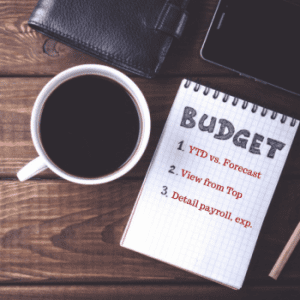 Tis the season and most hotels are already well under way with their annual grunt work to prepare a 2020 plan for the regional and corporate teams to review and then it is onward to ownership seeking their approval.
Tis the season and most hotels are already well under way with their annual grunt work to prepare a 2020 plan for the regional and corporate teams to review and then it is onward to ownership seeking their approval.
In most hotels, this process is a protracted drawn-out marathon of such epic duration that it leaves a streak of several weeks, if not months, for some to endure. Revision after revision is the norm and everyone along the path squeezes a little more until there is nothing left to give anymore.
When we consider the goal of the budget, it is pretty simple. Create a plan for the coming year that will provide everyone—the hotel team, the brand and the owner—with what they need to survive and, dare I use the word, prosper. The budget is a business plan for the hotel: a direction to follow to achieve financial objectives. It should speak to the strategy for the business and carry those ideas to the numbers for each area.
I have prepared and been involved in over 20 years of budgets at my hotels and I have been immersed in reviewing hundreds of budget submissions from other hotels in my regional and corporate positions. I learned a few shortcuts, tricks and above all else a process to follow. I am going to outline a few of all three here in this piece starting with some tips on the process.
Tip 1 – Conduct a complete review of year-to-date results vs. forecast to end of year
Do not make the mistake of the bait and switch because you will be caught and in turn you will lose all credibility with whoever is reviewing your budget.
Here is the scenario you must avoid: It is early September and you have the current year’s results as of August plus the forecast for the last four months.
When you look at the YTD actual performance, you are ahead of budgeted GOP for the year thus far (August) by $750,000. Good work. Yet when you look at the year-end forecast, the growth has slipped to only finishing the year ahead by $350,000! What happened to the $400,000?
This is where inexperienced, and I will use the word cocky, managers think they can pull the wool over the eyes of their master. Do not be the one to do this. Yes, there are tempting reasons for your skepticism about the last quarter of the year. Perhaps the group pace is down, the citywide numbers are soft or even the rate gains YTD are not sustainable. So what? It is your job at the very least to keep what you have YTD in the way of profit gains and not lose it. Do not be tempted to squirrel it away and spend in the last four months of the year in preparation for next year. If you try this trick you will be found out and forevermore known as a sandbagger.
The number one thing I learned about the process of preparing a budget is to take away the emotion leaders find as a by-product of what they think is the annual wish list. So often—especially new leaders and managers—they view the budget as the time to right all the wrongs. To ask for and push as hard as possible to get all the labor and expenses they absolutely need to “properly” run their department.
Annually, we need to counsel our department heads about their budget submissions and minimize the drama of having to tell Peter and Suzie that their 20 percent increase in overall costs just will not fly. It will never get off the ground.
Set the tone from the top with a clear message that the budget needs to be realistic within the parameters that are clearly laid out. A message something like this is very helpful before you start the detailed process: Departmental payroll for the coming year will be flat with a 2.5 percent increase in average wages coupled with a 3 percent improvement in productivity. Expenses are forecast to increase 3 percent next year and each manager is tasked with finding the corresponding savings in their department through a complete review and innovation. These two headlines set the tone of conservative business practices.
Tip 2 – Have a view from the top before you begin budget detail
This is akin to beginning with the end in mind. I learned this from one of my GMs. He ceremoniously called me to his office late one day which was always a first-class adventure in itself. On this visit, he asked me to prepare the following year’s budget and bring it to him the next morning at 10 a.m.
Was he completely mad and had he lost his final piece of grey matter? How could I possibly prepare the entire budget in just a few hours, most of which I was planning on sleeping.
“Simple,” he said.
“Take the top-level results from the last three years and add the latest forecast and include a fifth column for next year.”
“I want to see a 7.5 percent revenue gain on the top: 80 percent from rooms and most of the rest from F&B and I also want to see a 55 percent flow through to GOP,” he continued.
“Start with your new revenue and then figure out what the departmental numbers for payroll and expenses need to be to get the flow.”
I did exactly what he asked and I was done before 6 p.m. that day. We reviewed the “one-pager” the following morning and he did not change a thing.
“Now, David,” he said that morning, “you have the blueprint for next year—make sure each department head gets their numbers and only their own numbers for payroll, expenses, and if applicable, revenue.” This was magic.
Tip 3 – Get your managers to plan their payroll, expenses in detail
Do not let another year go by where you fly by the cost per cover or room occupied. Zero-base the expenses and have each manager prepare their detailed staffing guide. It will take them some extra time but it is well worth the investment. If you skip this part, you go another year without your managers knowing what is in the middle of their statements and this is akin to flying by the seat of your pants. Do not let it happen again this year. Here is a link to my recent article on zero-based expenses for the full story.
Alas, the biggest thing to remember about the budget that has a lot of weight is this:
“The only thing we know for sure about the budget is…it is wrong.”



















